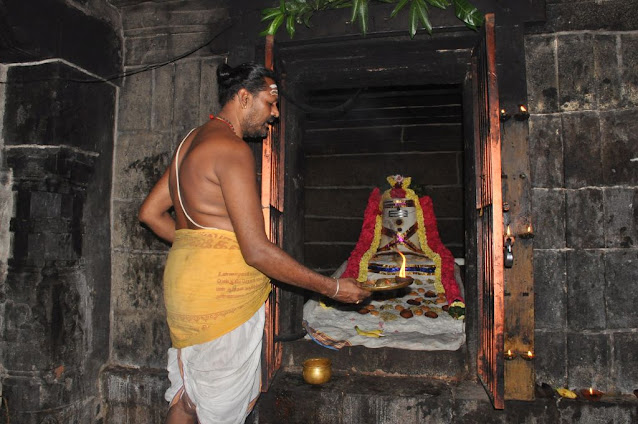"Some exquisite mural paintings that adorned Tamil Nadu’s Temples are lost thanks to neglect and state-sponsored vandalism. These treasures, belonging mostly to the Vijayanagar and Nayaka periods (14th - 17th century), have been whitewashed or sandblasted in the name of Temple renovation or kumbhabhishekam (a consecration ritual). Officials of the State Hindu Religious and Charitable Endowments Department have allowed the whitewashing or sandblasting of murals to present a clean surface to devotees, claiming that devotees do not like to see faded paintings."
For two earlier posts on sandblasting on Arunachala Grace, go to this
link here and this
one here. (Sandblasting is a process intended to remove oily substances or whitewash from statues and/or paintings. In the process sand is sprayed at high air pressure on sculptures, walls and pillars. It is now banned in many Temples in India.)

Mural depicting Nataraja, Kalakkad Temple
"In some cases, it is ignorance that has led to the neglect of these works of art. Soot from oil lamps settle over the murals; electrical cables and switchboards are installed over them; or cracked ceilings allow water and sunlight to seep in and spoil the murals.
In what conservationists describe as a classic example of ‘murder of art’, these paintings are reportedly repainted by signboard artists who merrily use modern poster-colours to re-create them. The State Archaeology Department use artists unfamiliar with the conservation or restoration of ancient murals to repaint murals found on the ceiling of some Temples wth the result, that the murals now dazzle in bright colours."
 Modern artist's repainted mural
Modern artist's repainted mural
The Temples where the few surviving murals have been mindlessly whitewashed include the Arunachaleswarar Temple, Tiruvannamalai and the Meenakshi Temple, Madurai amongst others. Palaces, forts, colonial bungalows, monasteries and churches in Madhya Pradesh, Gujarat, Rajasthan, Jammu and Kashmir and Goa face similar defacement.
Dr. David Shulman, an Indologist who has studied mural paintings of Tamil Nadu and Andhra Pradesh, says: “The problem is very urgent. If action is not taken immediately treasures of Tamil Nadu, which are part of the National Heritage, will disappear.” Very often Mandapams housing mural treasures of South India paintings are being used as godowns (food storage), or filled with junk, logs, rusting nails and even dead rodents! Experts in Fine Arts suggest organisations such as the Indian National Trust for Art and Cultural Heritage should consult tradition-oriented artists before taking up conservation of existing murals.
A four-day international seminar titled “Painting Narratives: Mural Painting Traditions in the 13th -19th centuries”, held near Chennai from January 23th to 27th, focussed on the magnitude of the problem. Attention was also drawn to the existence of hundreds of painted, wooden sculptures in Temples and Village deities (Ayyanars) and their Vahanas (mounts) being painted in garish rich colours.
 Brightly Painted Vahanas at Pachaiamman Temple, Tiruvannamalai
Brightly Painted Vahanas at Pachaiamman Temple, Tiruvannamalai
Experts explain why it is important to preserve these paintings: “Mural paintings are not only great works of art but serve a historical purpose by throwing light on contemporary society through dresses, ornamentation, hairstyle, musical instruments, arms and armoury, and a host of other details depicted in them. Some of the murals are about actual historical events such as battles, trading and missionary activities, although the great majority of them deal with mythological themes, including the epics Ramayana and Mahabharata, and the Bhagavatha. A comparative study of the styles and techniques in different periods can take us through the process of development of the art of mural painting at different stages in the past.”
 Repainted Mural at Varadarajaswamy Temple, Kancheepuram
Repainted Mural at Varadarajaswamy Temple, Kancheepuram
Sometimes the vandalisation of murals take a different turn: first, they are copied, the walls whitewashed and then “artists” engaged to repaint the murals on the walls. At some Temples, ancient murals have been lost because of sandblasting for the purpose of cleaning the surface on which they were painted.
Officials of the Arunachaleswarar temple at Tiruvannamalai whitewashed exquisite paintings at Ezhuthu Mandapa depicting stories from the Ramayana and Kandapuranam, and whitewashed and sandblasted murals about Krishna Leela on the ceiling of a corridor.
How can ancient murals be preserved? Experts believe that the key to the solution lies in creating an awareness among Temple officials and the devotees on the value of these exquisite mural paintings.
[With thanks to T.S. Subramanian]



























